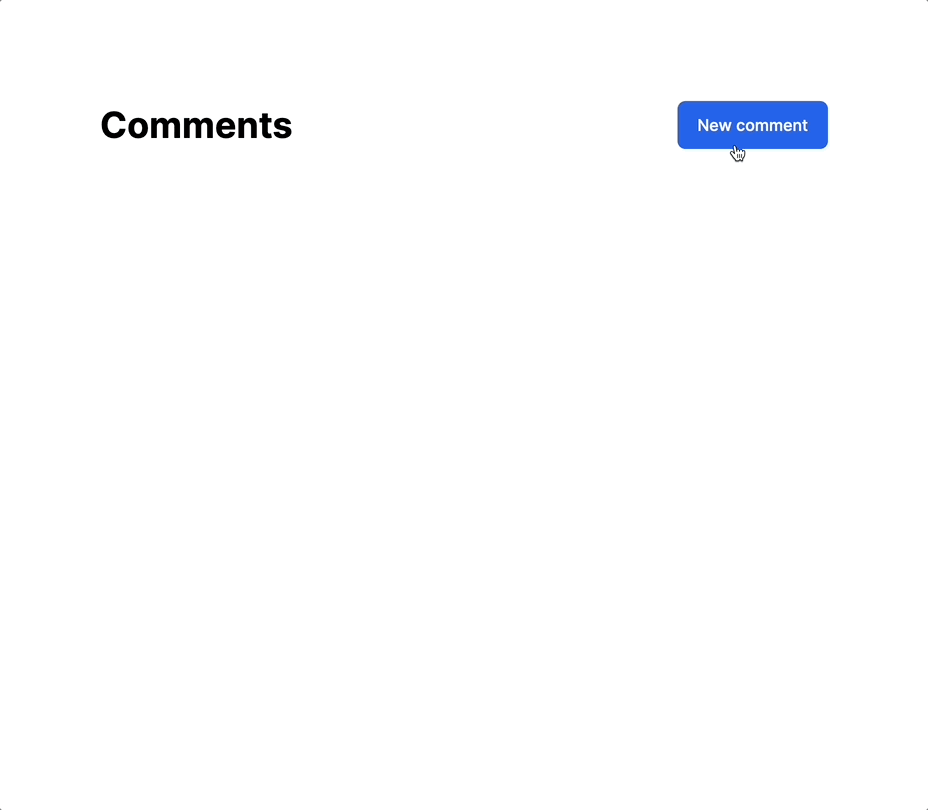 Revised: Hotwire Turbo Modals with HTML Dialog
Revised: Hotwire Turbo Modals with HTML Dialog
Previously I wrote about:
2) HTML Modals with Dialog element
We can combine the two to make the perfect modals!
Requirements:
- leverage HTML
<dialog>(default styling, close behaviours) - turbo frames: dynamic modal content, navigation
- handle form validation errors
- conditionally close modal after successful form submit
- respond with turbo_steam/redirect/turbo_frame refresh
Working example:

We will import dialog_controller.js from the previous post.
Additionally to handle turbo frames, we will:
- add a
frame_targetthat we clean up when dialog is closed - add
submitEndthat is fired when a form is submitted successfully
// app/javascript/controllers/dialog_controller.js
import { Controller } from "@hotwired/stimulus"
// Connects to data-controller="dialog"
export default class extends Controller {
- static targets = ["modal"]
+ static targets = ["modal", "frame"]
connect() {
this.modalTarget.addEventListener("close", this.enableBodyScroll.bind(this))
}
disconnect() {
this.modalTarget.removeEventListener("close", this.enableBodyScroll.bind(this))
}
open() {
this.modalTarget.showModal()
document.body.classList.add('overflow-hidden')
}
+ submitEnd(e) {
+ if (e.detail.success) {
+ this.close()
+ }
+ }
close() {
this.modalTarget.close()
// clean up the frame
+ this.frameTarget.removeAttribute("src")
+ this.frameTarget.innerHTML = ""
}
enableBodyScroll() {
document.body.classList.remove('overflow-hidden')
}
clickOutside(event) {
if (event.target === this.modalTarget) {
this.close()
}
}
}
Add dialog to layout to enable access to it globally.
-
data-controller="dialog"should be on<body>, so thatclick->dialog#openworks anywhere - Empty
turbo_frame_tag :modalinside<dialog> -
data: {dialog_target: "frame"}needed to remove content from frame when dialog is closed
# app/views/layouts/application.html.erb
<body data-controller="dialog" data-action="click->dialog#clickOutside">
<dialog data-dialog-target="modal"
class="backdrop:bg-gray-400 backdrop:bg-opacity-90 z-10 rounded-md border-4 bg-sky-900 w-full md:w-2/3 mt-24">
<div class="p-8">
<button class="font-bold float-right" data-action="dialog#close">X</button>
<%= turbo_frame_tag :modal, data: {dialog_target: "frame"} %>
</div>
</dialog>
<main class="">
<button data-action="click->dialog#open">Open dialog</button>
<%= yield %>
</main>
</body>
Now you can add data: { turbo_frame: :modal, action: "dialog#open" } to any link in your app. It will:
1) open dialog
2) replace the content of turbo_frame: :modal with content from the rendered page
<%= link_to 'Add comment', new_comment_path, data: { turbo_frame: :modal, action: "dialog#open" } %>
-
Content missing? -
=> Wrap the page into
turbo_frame_tag :modal - Modal does not close after successful form submit?
- => add
data-action="turbo:submit-end->dialog#submitEnd"to ensure that dialog is closed after successful form submit
# comments/new.html.erb
+<%= turbo_frame_tag :modal do %>
<h1 class="font-bold text-4xl">New comment</h1>
+ <div data-action="turbo:submit-end->dialog#submitEnd">
<%= render "form", comment: @comment %>
+ </div>
+<% end %>
Refactoring #
Problems with the above approach:
- We were needlessly adding a stimulus controller on the BODY html tag;
- dialog html was present in the layout file, even if we do not need it right now;
Solution:
Let’s remove the <dialog> from the layout file, and leave an empty turbo_frame_tag :modal
# app/views/layouts/application.html.erb
<body>
<%= turbo_frame_tag :modal %>
<%= yield %>
</body>
We will open
# app/views/layouts/_turbo_dialog.html.erb
<%= turbo_frame_tag :modal do %>
<dialog data-controller="dialog" data-action="click->dialog#clickOutside"
class="backdrop:bg-gray-400 backdrop:bg-opacity-90 z-10 rounded-md border-4 bg-sky-900 w-full md:w-2/3 mt-24">
<div class="p-8">
<button class="bg-slate-400" data-action="dialog#close">Cancel</button>
<%= yield %>
</div>
</dialog>
<% end %>
Wrap the views that should be rendered inside the modal with the new _turbo_dialog partial:
# app/views/comments/new.html.erb
# app/views/comments/edit.html.erb
# app/views/comments/show.html.erb
- <%= turbo_frame_tag :modal do %>
+ <%= render 'layouts/turbo_dialog' do %>
So now when a user clicks on a link that should open inside a modal, the content will be rendered within a hidden <dialog>. Let’s update the stimulus controller to automatically open this dialog:
// app/javascript/controllers/dialog_controller.js
// app/javascript/controllers/dialog_controller.js
import { Controller } from "@hotwired/stimulus"
// Connects to data-controller="dialog"
export default class extends Controller {
connect() {
+ this.open()
// needed because ESC key does not trigger close event
this.element.addEventListener("close", this.enableBodyScroll.bind(this))
}
disconnect() {
this.element.removeEventListener("close", this.enableBodyScroll.bind(this))
}
// hide modal on successful form submission
// data-action="turbo:submit-end->turbo-modal#submitEnd"
submitEnd(e) {
if (e.detail.success) {
this.close()
}
}
open() {
this.element.showModal()
document.body.classList.add('overflow-hidden')
}
close() {
this.element.close()
// clean up modal content
+ const frame = document.getElementById('modal')
+ frame.removeAttribute("src")
+ frame.innerHTML = ""
}
enableBodyScroll() {
document.body.classList.remove('overflow-hidden')
}
clickOutside(event) {
if (event.target === this.element) {
this.close()
}
}
}
We also cleaned up the redundant stimulus targets!
Perfect! Visually everything works the same, but this code is much better! 🎯
Disable certain pages to be opened outside modal #
# app/controllers/comments_controller.rb
before_action :ensure_frame_response, only: [:new, :create, :edit, :update]
def ensure_frame_response
redirect_to root_path unless turbo_frame_request?
end
Testing turbo frame requests #
get new_comment_path, headers: {"Turbo-Frame" => "new_comment"}
assert_response :success
post comment_path(comment), params: {comment: {body: 'foo'}}, headers: {"Turbo-Frame" => "new_comment"}
assert_response :success
Well, that’s it!
This approach works well for hotwire-based modals.
Did you like this article? Did it save you some time?